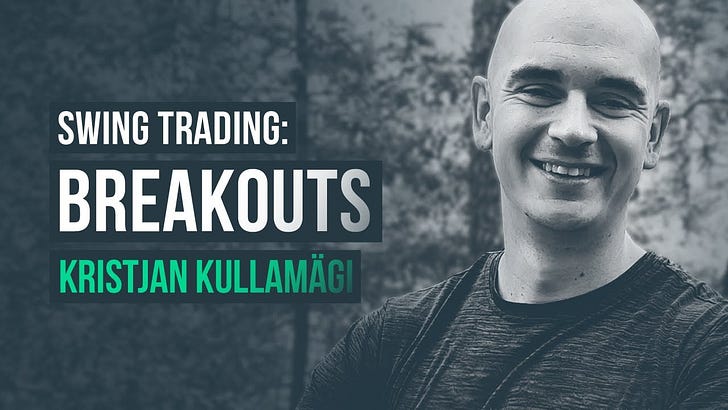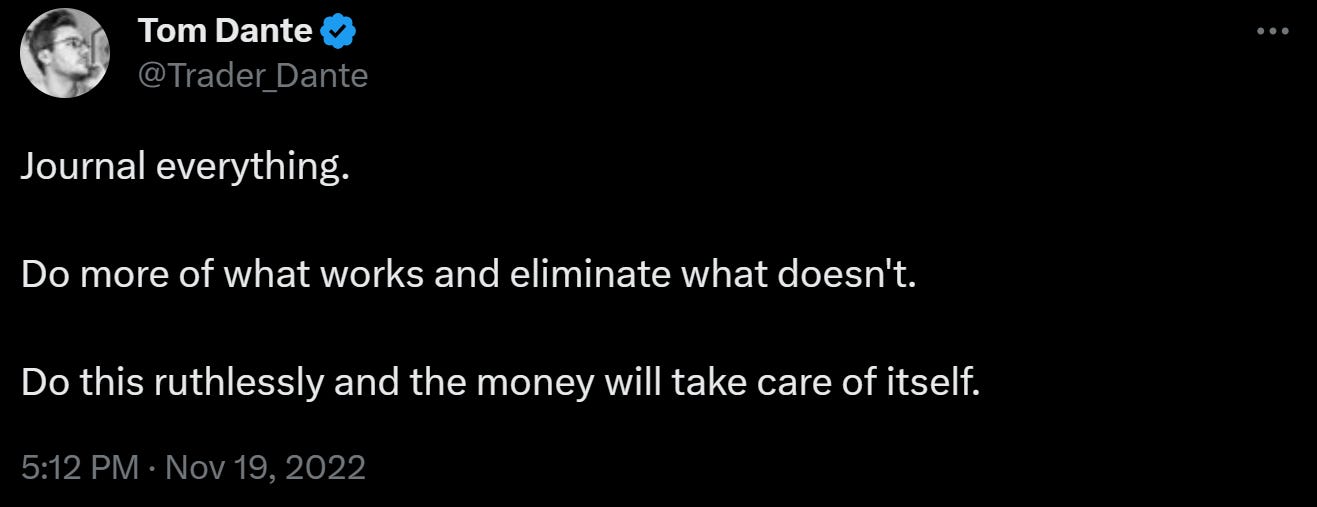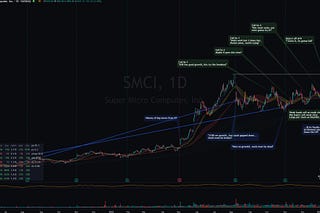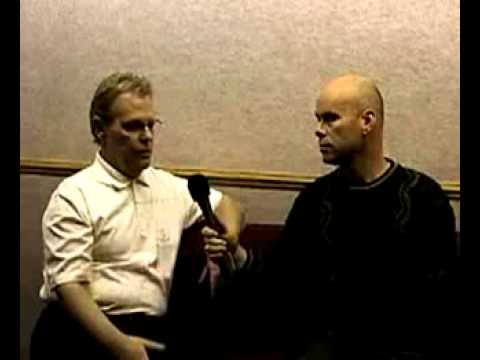Interview Notes: Qullamaggie on Chat With Traders (Part 2)
Kristjan's psychology, and a step-by-step approach to building conviction
Time for part 2 of my notes on Kristjan Kullamägi’s Chat With Traders interview (@Qullamaggie and @chatwithtraders on Twitter), which focuses on the psychology aspects of the interview — most notably, how Kristjan built conviction, and how you can build it too.
Part 1 focuses on the mechanics of Kristjan’s breakout strategy. It also includes an introduction to the overall interview that I won’t repeat here. However, as a reminder, the show notes and full podcast are available on chatwithtraders.com. Alternatively, you can listen to the interview on YouTube:
As always, my notes focus on what I considered to be the highlights, and include my own insights where I believe they add value.
I’m always open to feedback and/or new stack suggestions! Feel free to leave a comment below, message me on Twitter or email me at kayklingson@yahoo.com.
Incremental improvements
At the start of part 1, I mentioned how at the beginning of his trading journey, Kristjan blew up a few accounts. He also started as a day trader, then later transitioned to swing trading. Both these events were marked by an important concept, which is extremely practical but also has a huge psychological impact: regular, incremental improvements.
(In a recent post dedicated to performance psychology, I discussed investing in loss and continual self-improvement more generally.)
Blowing up accounts
Blowing up in their early days seems a common occurrence among the traders that eventually become great. At the very least, they suffered big losses that really hurt. The experience is inevitably an awful one, but also one that stays with them for life. Once a trader has experienced the pain of not managing risk, they are much more likely to be disciplined about risk management going forward. A very valuable lesson to learn.
Nevertheless, for Kristjan (and probably every other trader out there), each account blow-up did rattle his confidence. “It was a horrible experience — that was my life’s savings, at that time” (5:23). In similar vein, in a more recent interview, he said that “It is tough to lose money you have worked hard for.”
However, he also explained during the Chat With Traders interview that the time it took to blow up each new account gradually got longer because every time he “learned something new, I improved a little bit” (5:06). To quote from his website:
“I didn’t give up, I studied more, tried harder, did more of what worked and less of what didn’t work, my results started improving. Gradually I went from losing money to breaking even.”
Incremental improvements seem like the way to go, no matter the activity. Last week, I wrote about two theories of intelligence, which essentially boil down to attributing success (or failure) to either talent or hard work. The true champions believe predominantly in the latter: that by taking things step by step, you can gradually improve, making it possible for even novices to become masters.
And don’t forget: small improvements really do add up over time. Just look at Kristjan!
Transitioning to swing trading
When Kristjan started to hold positions overnight, this was very uncomfortable for him to begin with. However, he ensured that this transition was a gradual process, taking “one step at a time”, and he learned to control overnight risk.
When holding stocks for weeks and months on end, Kristjan also had to learn to hold through pullbacks (45:12). The following helped him with that:
Being selective about when he gets into the market — for breakouts, just as the market is coming out of a (preferably multi-month) pullback or correction, e.g. early November 2020.
Looking to trade and hold the leaders, which hold up better than the overall market by nature.
Again, incremental improvement is key here, though Kristjan’s first target — getting profitable — was largely about learning what does and doesn’t work in trading. His second goal — transitioning to a new strategy — was perhaps more characterised by being taken outside his comfort zone, and adopting the necessary new habits and tactics gradually. Acclimatisation, if you like.
To conclude, by giving yourself time to get used to the changes you make and ensure they become habitual, you make it much easier for yourself to achieve consistency. Dramatic, overnight changes are much less likely to stick.
A step by step to building conviction
Understandably, the interview itself didn’t discuss the below in a structured, step-by-step manner. However, I am a technical writer — I’m trained to explain complex material as clearly as possible in writing. Often, that means breaking the information up into steps, which is the approach I decided to take with the below too. I hope you find it useful!
Step 1: Learn how stocks move
In part 1, I mentioned that Kristjan went through all the stocks in the US market to study how stocks move. I suspect that far too many traders aren’t prepared to do that much work — but this no doubt was necessary for Kristjan to develop genuine conviction in swing trading, even if it was uncomfortable for him to start with.
Essentially, Kristjan discovered that stocks have been moving in the same patterns for hundreds of years, even all the way back in the late 19th century, which also showed up throughout the 20th century and into the 21st century, including in 2015, which is when Kristjan was doing this studying. It made him realise that if he can just master this one setup — the breakout setup and its variations — he could truly make a killing. “It felt like I had stumbled [upon] a goldmine, really!”
But merely learning this isn’t enough. You must also discover these patterns for yourself.
In other words, just hearing the information from Stockbee (14:50) or reading it in William O’Neil’s How to Make Money in Stocks, which is where Kristjan originally got the information from, isn’t enough. To truly believe it, he — and everyone else — needs to confirm it for themselves. Otherwise, how will you truly have conviction in these ideas, especially when they aren’t working very well (i.e. when the market conditions aren’t optimal, which is most of the time)?
Step 2: Build a database
From 15:50, Kristjan was asked how he started to build confidence in the breakout setup and its variations. A key part of his answer was studying thousands of historical examples (i.e. charts) by building an Evernote-based database.
You might call this a qualitative form of backtesting — after all, at the end of the day, trading is all about pattern recognition. If you don’t look at lots and lots of charts, how do you expect to be able to recognise those patterns accurately, particularly when under pressure?
Anyway, within his database, Kristjan included chart screenshots of before and after the breakout, on both daily and intraday time frames. This enabled him to study and internalise what a good setup looks like before the move, and how it should act when it starts breaking out, as well as a few weeks or months later. He also used this database to study breakout variations.
About fundamentals
Kristjan mentioned that building this type of database could focus on the technicals alone, but can also be combined with fundamentals — i.e. information such as themes, news, earnings, revenue, sales, etc. Kristjan found patterns in these too, discovering that the same things have been working for more than a century. He actually said that fundamentals help him have conviction (30:55):
“Just trading off momentum and chart patterns, you can make a very good living — but, I think, if you can combine some type of fundamentals, [you can make even more money]. Because at the end of the day, there are some type of fundamentals that drive these stocks. […] Fundamentals are the fuel, and momentum is […] what happens after the fuel.”
If you take the time and effort to find out what the “fuel” is — for example, big earnings and/or revenue growth — and combine this information with the fastest-moving stocks, you can develop a big edge.
Having said that, a lot of stocks that go up are just story stocks — they have no earnings or revenue. Some don’t even have a product. All the same: you need to know what’s driving these stocks. Kristjan often mentions this in his streams too, such as during the 19 May 2023 stream.
Kristjan referred to $QS as an example of where knowing the fundamentals really helped his trading. He discovered the stock (and company) at an early stage, and that it is involved with an exciting battery technology, at a time when EV- and battery-related stocks were hot. So he kept an eye on it, and once he saw momentum and volume come into the stock, and identified a setup, he traded it with “decent” size and conviction, and tried to hold it for longer. Whereas if it had just been a random name to him, he would have traded it with less size and conviction.
To conclude the discussion about fundamentals (34:06):
“I think [that] if I would take the fundamentals out of my trading, my profitability would drop a lot. Like, fundamentals […] do play a big role — at least, for me personally. It helps [give me] conviction. [That’s] really what it comes down to.”
Summarising Kristjan’s advice
Towards the end of the interview (1:06:40), Kristjan said that he felt a lot of people — even some fairly successful traders — would do even better if they really went back and looked at thousands of examples of the setup(s) they trade. As part of that process, they should really nail down all of their setup’s variations, as well as look at how the overall market was at the time of those setups.
Step 3: Gain experience
Another important step in Kristjan’s conviction-building journey was trading the breakout setup himself with some success. Again, he mentioned how he felt that he was constantly improving, learning new variations, and generally just learning new things. (Note the link with incremental improvement again!)
However, while you’re gaining experience by actually trading your setup, you should continue to study your database — even if it’s to only flip through all the charts again. At the very least, this will help you internalise the patterns. It may also help you spot details you’d previously missed.
You also need to have a decent awareness of overall market sentiment or trend — at least within your universe of stocks. Learning to read the environment is a skill that takes time to develop, but is vital to longevity in the markets. To learn it, you need to see a few market cycles for yourself so you can gain the necessary experience.
Step 4: Keep a journal and analyse it
This is actually my own addition, but it does link to a part of the interview, which I’ll get to in a moment.
First, I want to say that you can learn a lot from great traders like Kristjan. However, you should not seek to copy their exact strategy. I quote from Kristjan’s website:
“I learned from a lot of people; I was in many different chat rooms and trading communities, went to seminars, read a lot of books, articles etc. Picked up bits and pieces and developed my own thing that fits my own personality.
“I spent THOUSANDS of hours looking a big winning stocks over the past 100 years and figured out the patterns that happen over and over again and what fuels those big moves.”
Ultimately, while they share many core principles, good traders developed their strategy around their edge. Why should that edge be the same as yours?
Back to the interview. Kristjan mentioned that you should choose how fast you want your stocks to be (as in, the ones you choose to trade), but also that you “obviously” want to be in the fastest-moving stocks. My personal caveat to this would be that you should trade the fastest-moving stocks on which you are profitable.
It might be just a matter of insufficient studying on my part, or perhaps it’s something to do with my personality, but I have a negative expectancy on really fast-moving, volatile names. By crunching my numbers, I discovered that I do best with large caps and 5–7% ADR stocks (though I do take trades slightly above and below this range too). So my strategy is to enter these types of smooth-trading stocks near-perfectly, rarely needing more than a 1% stop, so I can trade them with a lot of size. During the day, I take some profits to reduce this size to an acceptable level to hold overnight.
I’m not alone in doing better on slower-moving names. Oliver Kell is a fairly high-profile example of another trader who finds more of an edge in slower movers. See this tweet, for example, as well as some of the replies. That tweet is from 2021; only a few days ago, Oliver tweeted something similar. And he is in good company: I’ve heard David Ryan say similar things in interviews/webinars, for instance, among many other well-known traders.
So, study lots of charts that feature your setup. Trade your setup, to gain experience as well as to collect data about your own trading. Then, take a hard look at your journal. What works for you, and what does not? You can — and should — learn from the greats, but can ultimately only trade as yourself.
Trading slower-moving names might not make you a 9-figure trader. But the aim is to find a strategy that makes you money. Furthermore, as I’ve highlighted several times in this post (and previously) already: seek continual, incremental improvements. The goal is to gradually, step by step, get better. Compounded, you can achieve so much more than you think.
To finish with a Tom Dante tweet (who is the main inspiration behind my approach to journaling):
Dedication and commitment
Database of charts aside, Kristjan says that he studied everything related to trading (1:11:23), especially during the weekends. He looked at every single angle and method. “I tried to absorb everything.”
As part of this, Kristjan read a lot of books and articles, and studied a lot of very successful traders. In the interview, he mentioned Dan Zanger as a specific example — Kristjan had studied everything Dan had written. This includes all his newsletters, going back to the 90s. Kristjan read through them and looked at the patterns Dan was looking for.
Over the years, Kristjan’s probably spent 10,000+ hours studying. He now doesn’t study as much anymore, because there aren’t many new things to learn. The same patterns and concepts repeat themselves constantly, which Kristjan’s got “a pretty good grasp” of. Nevertheless, he does still study, albeit not as much anymore.
In case you needed another reason to feel inspired by this guy.
But seriously. This is the sort of commitment you always see from the greats, no matter the endeavour. They don’t make excuses. They are prepared to go to lengths that most others are not, because they are so determined to either succeed or else die trying.
On that journey, they can see that they are continually improving, which motivates them and makes them want to push even harder, if only to see how good they can get. And they never stop seeking self-improvement, even if they’re already great at what they do.
Trading involves psychology, as does virtually any other competitive activity once you reach a certain level. This involves confidence, conviction, self-belief, taking effective actions, taking responsibility… Like it or not, all of these things link to work ethic. The good news is that anyone can do it, if they put their mind to it and stick with it. The bad news is that it takes a phenomenal amount of effort and dedication.
In a more recent interview, where Kristjan begins by explaining in detail how he got started with trading, the interviewer remarked how he is “a very dedicated person”, because when he goes ‘all in’, he really does go ‘all in’. (For context, she’s referring to how he didn’t even finish his degree, despite being so close to graduation, just to trade stocks full time. Kristjan replied that he indeed has a tendency to do that.)
Challenges for Kristjan
Despite his level, Kristjan knows he isn’t perfect. Although he’s addressed — or as he put it, “got rid of” — a lot of challenges over the years, at the time of this interview, he was still struggling with overtrading. In recent as well as older streams, he’s also still saying how, every year, he’s trying to trade less.
He also said that he lacked patience, and tended to sell too early, especially in the parabolic moves typical of 2020 following the Covid crash. In essence, he wasn’t following his own sell rules.
No doubt, he’s still looking to improve. No matter how good he gets, he’ll probably never stop seeking self-improvement.
Scaling up
Going back to Kristjan’s successes, perhaps the most notable one relates to scaling up (59:55). In other words, if his account doubles, so does his dollar position size and dollar risk (although he did mention a lag of perhaps a few months), but he doesn’t change anything in percentage terms. Plus, he never withdraws money from his account unless forced to (e.g. for living expenses), which compounds his account even quicker, of course.
Kristjan mentioned (1:07:42) that he knows a lot of traders that have essentially been trading the same size for the past 10 years. These traders have mastered their setup, and really know what they’re doing, but haven’t been able to scale their trading. Kristjan believes this is to be a big factor that sets him apart from many other traders. Not to mention how it’s key to achieving huge returns, especially in persistent, powerful bull markets!
Anyway, how come there are traders who simply can’t scale their trading beyond a certain point? It could be a matter of lifestyle choices. Or perhaps it’s psychological: being unable to risk beyond a certain dollar amount on any single trade.
If you double your account, and the market is still good, your position sizes should double too (in dollar terms, not percentage terms). Kristjan emphasises the importance of this: you must think in percentage terms. He actually cringes (as do I, by the way) whenever someone talks about ‘points’, because it lacks context. What a ‘point’ means varies per stock. It can even vary within the same stock (or index), but at different points in time. Whereas 1% (or another fixed percentage) is always clear and unambiguous.
I personally use an Excel-based tool to make sure I’m always scaling correctly. It automatically calculates the number of shares to buy from my current account size, so I don’t even need to remember to manually update it.
Margin
On the topic of scaling, Kristjan also mentioned that he uses margin a lot — but only when he has ‘earned’ it. In other words, only when things are going well. After all, leverage can both hurt you as well as supercharge your returns, depending on how you use it.
However, using margin is not essential to achieving great returns (1:03:26):
“If you’re not using any leverage or margin in your trading, [that’s] fine — you can have incredible returns never using any type of leverage.”
One trader that springs to mind as being reluctant to use leverage is David Ryan, and he’s won multiple US Investing Championships!
Summary
Time to summarise what I feel are the key psychological points from the interview:
Incremental improvements and investing in loss are critical.
No matter how good you get, you can always improve.
To build conviction and become a really good trader, you must study — for several thousand hours.
As your account grows, remember to scale your trading. To make this easier, think in percentages.
If you’re going to be able to commit to the above — in particular, investing in loss no matter the circumstances and spending thousands of hours studying — you have to be deeply committed to trading. Do you really want this? Do you actually enjoy the process itself enough to be able to realistically spend this much time with it?
Some questions for you
Now that you’ve read both parts, do you still want me to break up my stacks into multiple parts in future, provided I can make each part work as a stand-alone read?
And should I write up more interview notes in my usual approach — picking out what I feel are the highlights, restructuring/grouping them in a way that makes sense to my technical writer’s brain, and adding my own insights where I think they add value?
There are so many things I’d love to write about, and while I unfortunately can’t do everything, I always listen to what my readers have to say. Requests, suggestions, feedback — please share them all with me!
Instead of commenting below, you can also message me on Twitter or email me at kayklingson@yahoo.com.
More posts like this
Part 1 of this interview is available here.
All my Qullamaggie notes, including stream notes, are available here.
The Trading Resource Hub’s full archive is here.















Awesome stack. " Incremantal Improvement". Great lesson from this stack. Best wishes Kay.